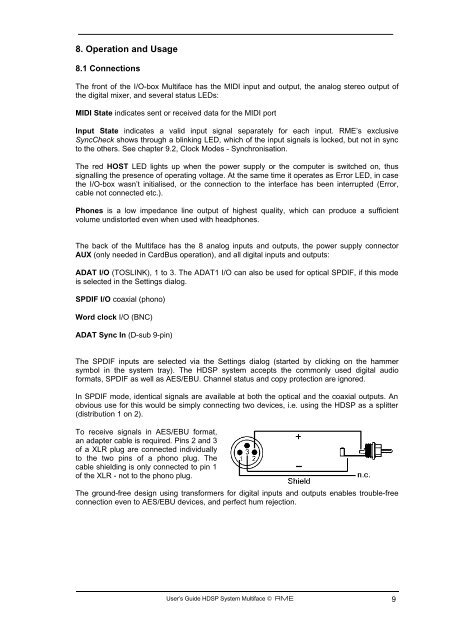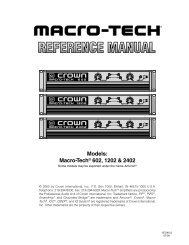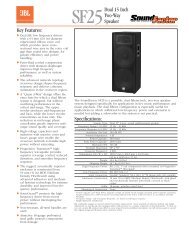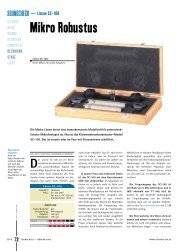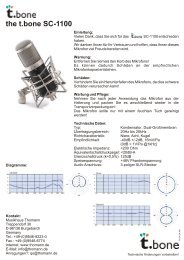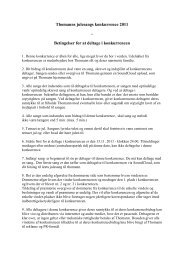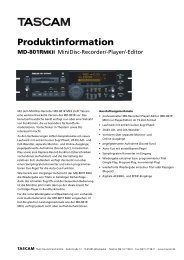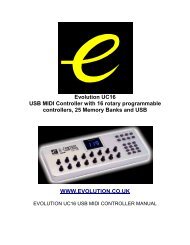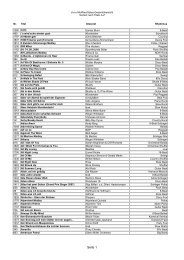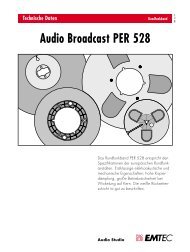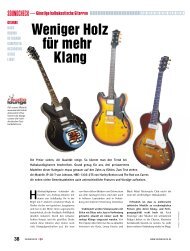Hammerfall® DSP System Multiface
Hammerfall® DSP System Multiface
Hammerfall® DSP System Multiface
You also want an ePaper? Increase the reach of your titles
YUMPU automatically turns print PDFs into web optimized ePapers that Google loves.
8. Operation and Usage<br />
8.1 Connections<br />
The front of the I/O-box <strong>Multiface</strong> has the MIDI input and output, the analog stereo output of<br />
the digital mixer, and several status LEDs:<br />
MIDI State indicates sent or received data for the MIDI port<br />
Input State indicates a valid input signal separately for each input. RME’s exclusive<br />
SyncCheck shows through a blinking LED, which of the input signals is locked, but not in sync<br />
to the others. See chapter 9.2, Clock Modes - Synchronisation.<br />
The red HOST LED lights up when the power supply or the computer is switched on, thus<br />
signalling the presence of operating voltage. At the same time it operates as Error LED, in case<br />
the I/O-box wasn’t initialised, or the connection to the interface has been interrupted (Error,<br />
cable not connected etc.).<br />
Phones is a low impedance line output of highest quality, which can produce a sufficient<br />
volume undistorted even when used with headphones.<br />
The back of the <strong>Multiface</strong> has the 8 analog inputs and outputs, the power supply connector<br />
AUX (only needed in CardBus operation), and all digital inputs and outputs:<br />
ADAT I/O (TOSLINK), 1 to 3. The ADAT1 I/O can also be used for optical SPDIF, if this mode<br />
is selected in the Settings dialog.<br />
SPDIF I/O coaxial (phono)<br />
Word clock I/O (BNC)<br />
ADAT Sync In (D-sub 9-pin)<br />
The SPDIF inputs are selected via the Settings dialog (started by clicking on the hammer<br />
symbol in the system tray). The H<strong>DSP</strong> system accepts the commonly used digital audio<br />
formats, SPDIF as well as AES/EBU. Channel status and copy protection are ignored.<br />
In SPDIF mode, identical signals are available at both the optical and the coaxial outputs. An<br />
obvious use for this would be simply connecting two devices, i.e. using the H<strong>DSP</strong> as a splitter<br />
(distribution 1 on 2).<br />
To receive signals in AES/EBU format,<br />
an adapter cable is required. Pins 2 and 3<br />
of a XLR plug are connected individually<br />
to the two pins of a phono plug. The<br />
cable shielding is only connected to pin 1<br />
of the XLR - not to the phono plug.<br />
The ground-free design using transformers for digital inputs and outputs enables trouble-free<br />
connection even to AES/EBU devices, and perfect hum rejection.<br />
User’s Guide H<strong>DSP</strong> <strong>System</strong> <strong>Multiface</strong> © RME 9


